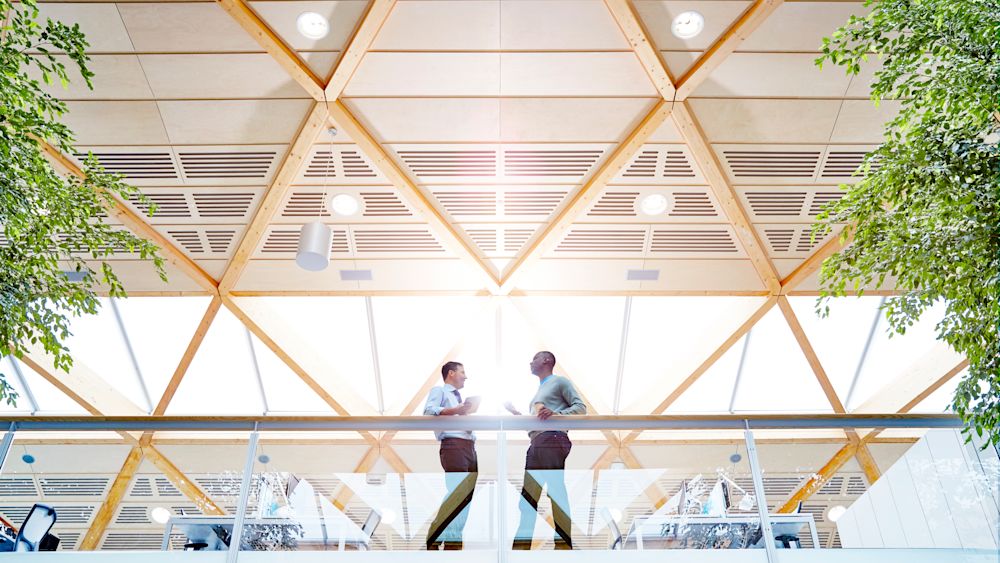- Iterate
- Employee Engagement & Retention
- Return to Office: How Office Design Will Shape the Future of Work
Return to Office: How Office Design Will Shape the Future of Work
Table of contents
How will organizations shift office design to entice workers back to the office?

Remote works. We all know it. The last two years have proven that working from an office desk is not a prerequisite for productivity. And we’d like it to stay that way: 86% of workers want to work from home at least a couple of days a week moving forward, according to data from a poll conducted by management consultancy Advanced Workplace Associates.
Nonetheless, companies are pushing to work in person again, with corporations like Microsoft announcing this month that employees are expected to be in the office at least half the time. If such a sizable percentage of office jobs can be done effectively from home, why the push to go back to the office? And what do they need to do to tempt us?
The power of in-person
Business is about people. We thrive among colleagues we know well and trust. Since we have all managed to work and collaborate remotely though, why the need for in-person interaction? According to author Simon Sinek, “we’re missing the fact that many of the relationships pre-existed,” which is a major factor in why it has been successful.
So while we can work effectively with our current colleagues, what about new hires? What if we move companies and have to integrate into new teams? Meeting in person is the most effective way. “You build trust between the meetings,” Sinek told The Org, in the conversation before and after, the seemingly insignificant interactions that we don’t have once we’ve logged off, but would have in office corridors. If teams were particularly determined, they could deliberately schedule online meetings just for chit-chat, but as Sinek puts it: “trying to build trust without any kind of human contact is way more difficult,” as well as unnatural.
And trust isn’t the only factor. Meeting virtually struggles to imitate many social situations integral to business, brainstorming perhaps suffering most. “You just don’t have the same flow of ideas. You can’t interrupt each other easily,” Sinek said. Sitting in person with a group of colleagues all talking over each other excitedly as an idea evolves just can’t be done online. While we’ve all coped out of necessity until this point, teams that now choose to return to in-person collaboration will noticeably surpass those that don’t.
Offices designed for people
Despite these benefits, demanding that employees return to an office which looks and functions identically to two years ago despite the success of remote working is actually going to have a negative impact on staff morale and foster resentment. Much more preferable would be employees returning willingly because they want to work from the office.
To coax workers out of the comfort of their home, the pros of remote work such as not commuting, being able to watch the kids or pets, and the freedom to run errands in our breaks, need to be outweighed. Now that employees have more of a choice, cubicles won’t cut it. The office has to be better than home.
Matt Colleran, Head of Design at London’s Design & Build firm TDA, spoke with The Org about how the role of the office and their approach to workspace design is evolving. Agile working (a design strategy characterized by a lack of dedicated desks, allowing employees to choose between several busier and quieter neighborhoods within the office) has long been promoted by these firms for its space-saving and overhead-reducing nature, but it seems clients are finally getting on board: “The days of rows and rows of desks are gone,” Colleran said. "The office is no longer just a place you have to go to do your work 5 days a week to be seen. There’s been a massive shift towards ‘how do you bring people back to work?’ and it’s down to people. What do they need, what do they want, what do they not have at home?”
The answer is two-fold: social and solutions.
Solutions vary from business to business but aren’t available when working from home. This could be specialist equipment, resources, or IT and A/V solutions. Just as important are people-oriented furniture and design solutions that cater to all their employees’ needs, from whiteboard and bean-bag brainstorm areas to formal client-facing meeting rooms, as well as areas to work quietly alone, and to rest and relax. The implementation of desk booking software also removes the dread of turning up to the office and not having the space you need.
Connect Slack or your HRIS system to get started
- Get a free, dynamic org chart using existing tools like Slack or your HRIS
- Integrate your ATS and place your open jobs in your org chart
- Show off your team and boost your employer brand
Besides solutions, what we don’t have at home is the social side of work that offices facilitate; discussing forecasts, planning projects, and catching up over coffee – all essential for truly successful teams. That being said, a couple of days of meetings and brainstorming sessions doesn’t constitute a five-day work week. What about all the work we do better alone, undisturbed? Can hybrid working policies afford us the freedom to do that work wherever we choose?
The future of the office
“Offices will always play a part,” Colleran explained. ”But we won’t be there 100% of the time. It all depends on businesses and how they work. Definitely in the future there will be flexibility. For example, a technical designer needs days to collaborate in person, but also days alone to focus on detailed work, which can be done at home.”
Similarly, Sinek envisions that “things will become a little more fluid, where people will actually have the option to telework when they can and when they need to.” He also expects working partly in-office and partly remote to become “way more socially acceptable.”
Regarding the spaces themselves, the real estate market has seen a flight to quality. While companies are looking to reduce their footprint, they want better buildings that provide enhanced environments and contribute to staff wellbeing.
Commenting on further trends we’ll see emerge, Colleran said, “In five years’ time, offices will be much more about people than they were before, built for the employee rather than the employer.”
“The focus is ‘how can we draw people into these buildings and make it into an experience for them?’ We’ve all realized working from home that you can sit on a sofa or the kitchen island to work. More and more, businesses will provide settings for people to work more comfortably and efficiently; active social settings for their employees, big kitchen areas, collaborative areas, but also alternative spaces for people who don’t like that, giving them quiet spaces. This was always the way office design was heading, but the last two years have sped up these trends.”
Don’t get left behind
Any company striving to recreate the magic of a lively work environment needs to put in the effort to entice employees back of their own accord. Businesses that choose to invest in providing spaces employees are eager to return to – while building a flexible company culture of trust and autonomy – are the ones that will retain talent going forward.
The future of work can be office-based if our offices are designed for us; a hub we choose to visit when we want and need to, not a desk we’re required to work from.
Get in front of millions of visitors and job seekers.
- Showcase your company culture to a vast community of professionals
- Host your team on a free org chart to keep employees aligned
- Post jobs on our free job platform for high growth startups
In this article


The ORG helps
you hire great
candidates
Free to use – try today